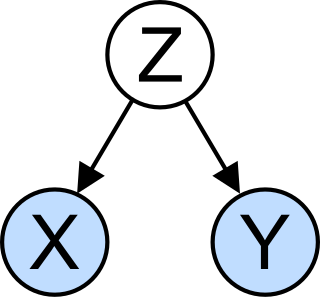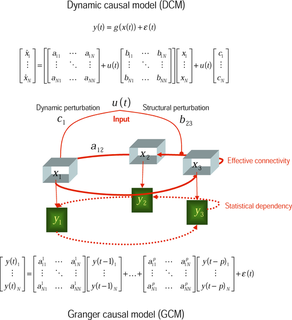Related Research Articles
Validity is the main extent to which a concept, conclusion or measurement is well-founded and likely corresponds accurately to the real world. The word "valid" is derived from the Latin validus, meaning strong. The validity of a measurement tool is the degree to which the tool measures what it claims to measure. Validity is based on the strength of a collection of different types of evidence described in greater detail below.
An ecological fallacy is a formal fallacy in the interpretation of statistical data that occurs when inferences about the nature of individuals are deduced from inferences about the group to which those individuals belong. 'Ecological fallacy' is a term that is sometimes used to describe the fallacy of division, which is not a statistical fallacy. The four common statistical ecological fallacies are: confusion between ecological correlations and individual correlations, confusion between group average and total average, Simpson's paradox, and confusion between higher average and higher likelihood.

In statistics, a spurious relationship or spurious correlation is a mathematical relationship in which two or more events or variables are associated but not causally related, due to either coincidence or the presence of a certain third, unseen factor.
In psychometrics, predictive validity is the extent to which a score on a scale or test predicts scores on some criterion measure.
In the behavioral sciences, ecological validity is often used to refer to the judgment of whether a given study's variables and conclusions are sufficiently relevant to its population. Psychological studies are usually conducted in laboratories though the goal of these studies is to understand human behavior in the real-world. Ideally, an experiment would have generalizable results that predict behavior outside of the lab, thus having more ecological validity. Ecological validity can be considered a commentary on the relative strength of a study's implication(s) for policy, society, culture, etc.

In statistics, the coefficient of determination, denoted R2 or r2 and pronounced "R squared", is the proportion of the variation in the dependent variable that is predictable from the independent variable(s).
In statistics, econometrics, epidemiology and related disciplines, the method of instrumental variables (IV) is used to estimate causal relationships when controlled experiments are not feasible or when a treatment is not successfully delivered to every unit in a randomized experiment. Intuitively, IVs are used when an explanatory variable of interest is correlated with the error term, in which case ordinary least squares and ANOVA give biased results. A valid instrument induces changes in the explanatory variable but has no independent effect on the dependent variable, allowing a researcher to uncover the causal effect of the explanatory variable on the dependent variable.
External validity is the validity of applying the conclusions of a scientific study outside the context of that study. In other words, it is the extent to which the results of a study can be generalized to and across other situations, people, stimuli, and times. In contrast, internal validity is the validity of conclusions drawn within the context of a particular study. Because general conclusions are almost always a goal in research, external validity is an important property of any study. Mathematical analysis of external validity concerns a determination of whether generalization across heterogeneous populations is feasible, and devising statistical and computational methods that produce valid generalizations.
In statistics, canonical analysis belongs to the family of regression methods for data analysis. Regression analysis quantifies a relationship between a predictor variable and a criterion variable by the coefficient of correlation r, coefficient of determination r2, and the standard regression coefficient β. Multiple regression analysis expresses a relationship between a set of predictor variables and a single criterion variable by the multiple correlation R, multiple coefficient of determination R², and a set of standard partial regression weights β1, β2, etc. Canonical variate analysis captures a relationship between a set of predictor variables and a set of criterion variables by the canonical correlations ρ1, ρ2, ..., and by the sets of canonical weights C and D.
In psychology, the take-the-best heuristic is a heuristic which decides between two alternatives by choosing based on the first cue that discriminates them, where cues are ordered by cue validity. In the original formulation, the cues were assumed to have binary values or have an unknown value. The logic of the heuristic is that it bases its choice on the best cue (reason) only and ignores the rest.

In statistics, a confounder is a variable that influences both the dependent variable and independent variable, causing a spurious association. Confounding is a causal concept, and as such, cannot be described in terms of correlations or associations. The existence of confounders is an important quantitative explanation why correlation does not imply causation.
In statistics, unit-weighted regression is a simplified and robust version of multiple regression analysis where only the intercept term is estimated. That is, it fits a model
Egon Brunswik Edler von Korompa was a psychologist who made contributions to functionalism and the history of psychology.

In the philosophy of science, a causal model is a conceptual model that describes the causal mechanisms of a system. Causal models can improve study designs by providing clear rules for deciding which independent variables need to be included/controlled for.

A quasi-experiment is an empirical interventional study used to estimate the causal impact of an intervention on target population without random assignment. Quasi-experimental research shares similarities with the traditional experimental design or randomized controlled trial, but it specifically lacks the element of random assignment to treatment or control. Instead, quasi-experimental designs typically allow the researcher to control the assignment to the treatment condition, but using some criterion other than random assignment.
In statistics, regression validation is the process of deciding whether the numerical results quantifying hypothesized relationships between variables, obtained from regression analysis, are acceptable as descriptions of the data. The validation process can involve analyzing the goodness of fit of the regression, analyzing whether the regression residuals are random, and checking whether the model's predictive performance deteriorates substantially when applied to data that were not used in model estimation.
The following outline is provided as an overview of and topical guide to regression analysis:
Incremental validity is a type of validity that is used to determine whether a new psychometric assessment will increase the predictive ability beyond that provided by an existing method of assessment. In other words, incremental validity seeks to answer if the new test adds much information that cannot be obtained with simpler, already existing methods.
In statistics, linear regression is a linear approach for modelling the relationship between a scalar response and one or more explanatory variables. The case of one explanatory variable is called simple linear regression; for more than one, the process is called multiple linear regression. This term is distinct from multivariate linear regression, where multiple correlated dependent variables are predicted, rather than a single scalar variable.
References
- ↑ Aronson, E., & Carlsmith, J. M. (1968). Experimentation in social psychology. In G. Lindzey & E. Aronson (Eds.), The handbook of social psychology (2nd ed., Vol. 2, pp. 1-79). Reading, MA: Addison-Wesley.
- ↑ Brunswik, E. (1956). Perception and the representative design of psychological experiments. (2nd ed.). Berkeley: University of California Press.
- ↑ Hammond, K. Ecological Validity: Then and Now. September 1998, available at: http://www.brunswik.org/notes/essay2.html#repdesign